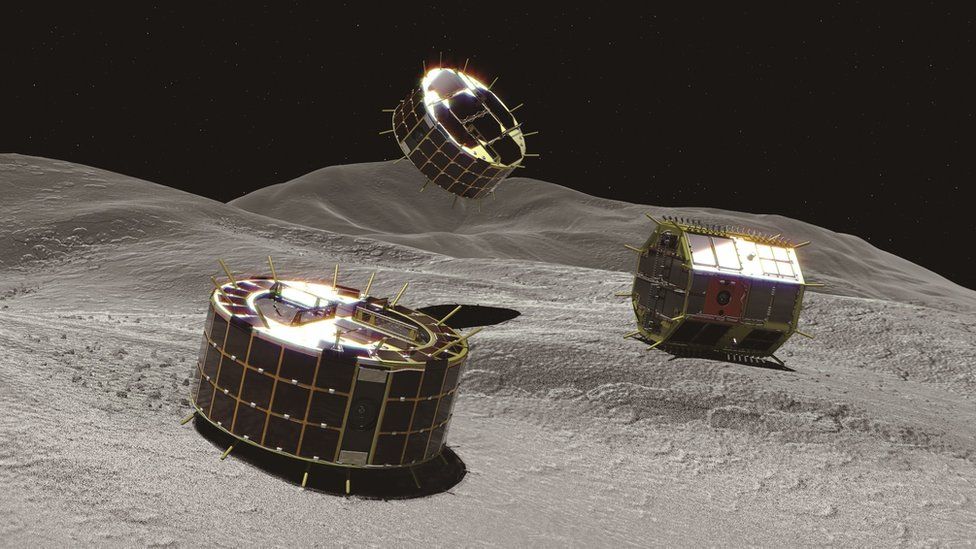Hayabusa-2: Japan's rovers ready for touchdown on asteroid
- Published

Two robotic explorers are descending to the surface of an asteroid.
Japan's Hayabusa-2 spacecraft despatched a pair of "rovers" to the 1km-wide space rock known as Ryugu.
If all goes well, Hayabusa-2 will be the first spacecraft to successfully place robot rovers on the surface of an asteroid.
Rover 1A and Rover 1B will move around by hopping in Ryugu's low gravity; they will capture images of the surface and measure temperatures.
Hayabusa-2 reached the asteroid Ryugu in June this year after a three-and-a-half-year journey.
The 1km-wide space rock known formally as 162173 Ryugu belongs to a particularly primitive type of asteroid, and is therefore a relic left over from the early days of our Solar System. Studying it could shed light on the origin and evolution of our own planet.
The rovers are stored in drum-shaped container at the base of the Hayabusa-2 "mothership". Collectively, they form a 3.3kg science package known as Minerva II-1.
Early on Thursday morning (BST), Hayabusa-2 began descending towards the surface of Ryugu in preparation for the deployment.
At around 0500 BST on Friday (1pm JST) - at a distance from the asteroid of about 60m - Hayabusa-2 initiated the release of the two robots.
Japanese space agency officials said that when the front of the drum is jettisoned into space, the two rovers are then ejected from the container and fall independently to the surface of the asteroid.
The 1kg autonomous rovers move about by hopping, using the asteroid's low gravity. Each one contains a motor-powered internal mass that rotates to generate force, propelling the robot across the surface.
They're equipped with wide-angle and stereo cameras to send back pictures from Ryugu. Spine-like projections from the edges of the hoppers are sensors that will measure surface temperatures on the asteroid.
They will send back their data to the mothership, which will then relay the information to Earth.
One of the principal concerns for deployment is the rougher-than-expected surface of Ryugu, which is carpeted with boulders with very few smooth patches.
The name Minerva comes from a detachable mini-lander carried on the first Hayabusa spacecraft, which explored a different asteroid - 25143 Itokawa - in the mid-2000s. However, a glitch during the deployment meant that little lander never reached its target.
Officials and scientists from the Japanese Aerospace Exploration Agency (Jaxa), which operates Hayabusa-2, will be hoping for better luck this time.
Hayabusa-2 was launched from the Tanegashima Launch Center in far southern Japan on 3 December 2014. It has been carrying several science instrument payloads for release on to the surface of its target, Ryugu.
On 3 October, the mothership will deploy a lander called Mascot, which has been developed by the German Aerospace Center (DLR) together with the French Space Agency (CNES).
And in late October, Hayabusa-2 will descend to the surface of Ryugu to collect a sample of rock and soil.
Even further on in the mission, Jaxa plans to detonate an explosive charge that will punch a crater into the surface of Ryugu.
Hayabusa-2 would then descend into the crater to collect fresh rocks that have not been altered by aeons of exposure to the environment of space.
These samples will then be sent to Earth for laboratory studies.
The spacecraft will depart from Ryugu in December 2019 with the intention of returning to Earth with the asteroid samples in 2020.
Follow Paul on Twitter.